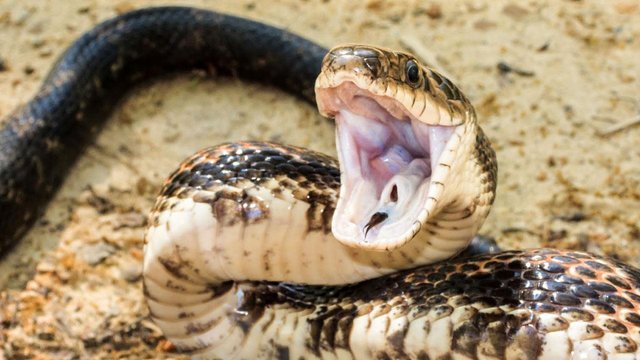Snakes Possess An Astounding Superpower
In recent posts, I've talked about the hunting habits of snakes. Many species, such as pit vipers, wait patiently for their meals, sometimes remaining motionless for days or even weeks at a time, waiting for the perfect moment to strike. Others are more mobile, actively stalking and hunting their prey. But when it comes down to the final moment, when their prey is finally just within reach, all snakes cannot afford to miss their target (who knows when they will get another chance?). To ensure the opportunity does not escape them, nearly all snakes employ an ability that is a practical superpower.

What snakes lack in size or strength, they more than make up for in sheer speed. When snakes strike, they are incredibly fast; even the slower, 'lazy' pit vipers can strike far faster than you probably ever realized. So how fast does a snake move during a strike? A 2016 study found that the average strike lasts between 44 and 70 milliseconds! If that doesn't seem impressive, compare it to the the 200 milliseconds it takes you just to blink your eye; theoretically, in the time it takes you to blink, a really ruthless snake could strike 4 times (though in reality, not so much). A snake can strike faster than we can move ANY part of our bodies, in fact, if you could attain snake super speed, you would simply black out.
"Essentially the prey doesn't stand a chance in most encounters. We're talking about animals that can strike out and reach their target before the prey is even perceptually aware that it's under attack." -David Penning, University of Louisiana Source

Though very few of the world's ~3,500 snake species have been studied in this manner, it was found that nearly all snakes that were investigate were capable of this incredible acceleration...from the smallest vipers to the largest pythons. This ability is all thanks to their unique physiology, which has evolved over millions of years to turn snakes into the real world equivalent of the Flash.

Snakes have a lot more muscles than we do, more than most animals in general. The human body contains somewhere between 700 and 800 different muscles that control our movements. The snakes' explosive movement is powered by 10,000 to 15,000 muscles! Though herpetologists are still somewhat unsure of how these muscles can be exploited to generate such acceleration, many theorize that the muscles connect to one another building up energy before striking in an elastic movement similar to a rubber band.

But their super-speed comes with a baffling question: how do snakes withstand the incredible forces on their bodies (forces that would completely incapacitate nearly all other animals)? The study found that snakes experience forces up to 30G, 30 times the force of gravity when striking their prey. For human comparison, even the most seasoned fighter pilots would lose limb control around 8G, and experience complete black out shortly after reaching 10G.
"We know that chameleons and some salamanders shoot their tongues towards their prey when attacking, and they can hit accelerations which are many, many times greater than snake strikes. But the key difference is that the tongue is travelling, not the brain." -Penning Source
"The brain is an incredibly delicate organ that is super-sensitive to accelerations and impacts. That's why American footballers have helmets and concussions are such a serious thing." -Penning Source

The fighter pilot would lose consciousness as he accelerated because the blood would be pushed towards the feet, depriving the brain of oxygen. But snakes seem to be completely unaffected by this problem for reasons that are yet to be completely understood. Penning was very interested in how the snakes tolerated the impact of their own strikes; thanks to their massive acceleration, snakes hit their prey with enormous force...enough force that theoretically, the brain shouldn't be able to survive. Penning believes the unique shape and design of the snake skull protects the brain from damage.
"The skull of a snake is incredibly kinetic and mobile. There are so many different joints which allow stretching and mobility. It could be that if one part lands first, it can absorb a little bit of shock before that's transferred to another part, so the snake can absorb the impact of the strike far easier and it doesn't concuss them." -Penning Source

Researchers are now diligently working to study how snakes' skeletal and nervous systems operate under the extreme conditions of a strike. Their goal: to find news ways to protect the human body when exposed to great forces. By studying snake attacks, we may be able to design safer vehicles that are far more effective at protecting passengers during bad crashes.
"We're currently trying to work out exactly what happens on impact when the snake hits its target. Snakes are able to launch their heads, stop, immediately withdraw to a defensive position and then repeat this again and again and again. So the question is, what is it about them which enables that impact to be sustained relatively easily, and can we use that for our own benefit in the future?” -Penning Source

Image Links: 1, 2, 3, 4, 5, 6, 7
Article Link: http://www.bbc.com/earth/story/20160511-almost-all-snakes-have-the-same-mindboggling-superpower
Very nice summary! I actually know both Brad Moon and David Penning. I was in the same graduate student presentation competition with David at the last herp conference. He won because he's amazing!
That's really cool! I'm really hoping to make it to this year's conference!
That's awesome! I really wanted to go to Austin this year but probably won't. Hope you make it there!
Sometimes we get lucky and can convince the facility that it's work related and they sponsor us. Hopefully we can get a deal this year!
Thanks for this great article! :)